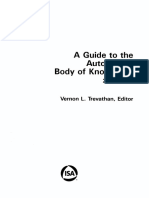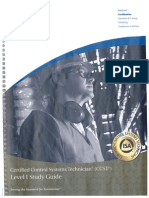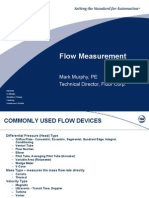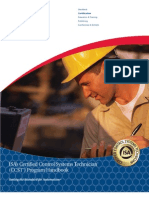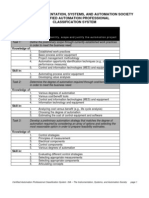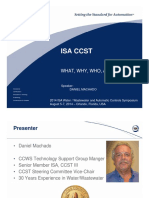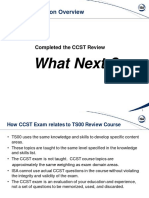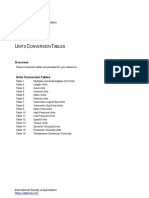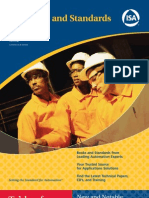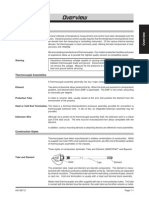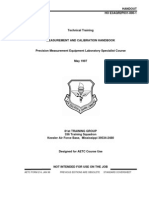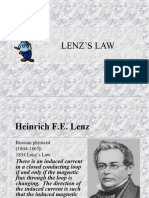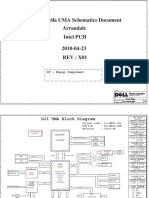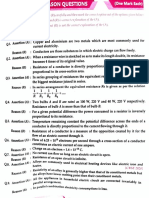CCST Question
CCST Question
Uploaded by
Ahmed RamadanCopyright:
Available Formats
CCST Question
CCST Question
Uploaded by
Ahmed RamadanOriginal Description:
Copyright
Available Formats
Share this document
Did you find this document useful?
Is this content inappropriate?
Copyright:
Available Formats
CCST Question
CCST Question
Uploaded by
Ahmed RamadanCopyright:
Available Formats
CCST question The relationship between thermocouples and thermopiles is: A. thermocouples consist of two or more thermopiles. B.
thermopiles consist of two or more thermocouples. C. thermocouples only measure heat conductivity. D. thermopile is another name for thermocouple. CCST answer A thermocouple is a temperature-measuring instrument that develops an electric voltage when heated because of the combined thermoelectric effect caused by the dissimilar composition of two electrically connected conductors-usually wires-and by the temperature difference between the connection-hot junction-and the other end of the conductors-cold junction. A thermopile is an array of thermocouples that serves either to measure temperature or radiant energy or to convert radiant energy into power. The thermocouples may connect in series to give a higher voltage output or in parallel to give a higher current output. The correct answer is B. Which orifice plate is used to eliminate damming of material at the top or bottom of the pipe? A. Concentric B. Round-edged C. Quadrant-edged D. Segmental CCST answer An orifice plate is a flow-path restriction that we use in flow detection. They are in a straight run of smooth pipe away from valves and fittings so they do not interfere with the restrictor and readings. The pressures on opposite sides of the plate are different, and the difference in pressures is proportional to the flow rate. Segmental and eccentric plates have many similarities as to function. The segmental portion of the orifice mitigates the damming of foreign materials on the upstream side of the orifice.
Eccentric orifice plates work to stop damming as well. The best answer to this question is D, segmental.
CCST question A beveled orifice should form an angle of: A. Not less than 30 degrees to the axis of the pipe B. Not more than 30 degrees to the axis of the pipe C. Not less than 45 degrees to the axis of the pipe D. Not more than 45 degrees to the axis of the pipe CCST answer The orifice plate inserted in the line causes an increase in flow velocity and a corresponding decrease in pressure. The flow pattern shows an effective decrease in the cross section beyond the orifice plate, with a maximum velocity and minimum pressure at the vena contracta. The vena contracta is that area of the flow stream at its minimum size, where fluid velocity is at its highest level and where fluid pressure is at its lowest level, and it occurs just downstream of the actual physical restriction. This flow pattern and the sharp leading edge of the orifice plate that produces it are of major importance. The angle of the bevel should not be less than 45 degrees. The best answer is C. The most common pressure tap is the: A. Corner B. Flange C. Pipe D. Vena contracta CCST answer The purpose of pressure taps is prevent gas or vapor accumulations in the connections between the pipe and differentialpressure (dP) measuring device. There are five common locations for dP taps. They are flange taps, vena contracta taps, radius taps, full-flow (or pipe taps), and corner taps.
In the U.S., flange taps are the predominant choice for pipe sizes 2 inches (50 mm) and larger. The best answer is B, flange. CCST question Control valves, which have a plug positioned by a stem, which slides through a packing gland, are often referred to as: A. Rotary motion control valves B. Linear stem motion control valves C. Ball-control valves D. Motorized control valves CCST answer A rotary valve has a flow closure member that rotates in the flow stream to modify the amount of fluid passing through the valve. A linear valve or a globe valve refers to the linear or straight-line movement of the plug and stem. Some valves use a movable part like a ball, a disk, a gate, in the flow path to modify the rate of flow through the valve. The best answer to this question is B. CCST question The Coriolis effect is associated with the: A. Head meter B. Magnetic flowmeter C. Positive displacement meter D.Turbine meter CCST answer Using the Coriolis effect that causes a laterally vibrating tube to distort, a direct measurement of mass flow is obtainable using a Coriolis flowmeter. Furthermore, a direct measure of the density of the fluid is also possible.
Coriolis measurement can be very accurate irrespective of the type of gas or liquid that is measured; the same measurement tube works for hydrogen gas and peanut butter. The correct answer is B, mass flowmeter. CCST question Which meter does not use an obstruction? A. Head meter B. Magnetic flowmeter C. Open channel meter D.Turbine meter CCST answer A magnetic flowmeter is a volumetric flowmeter, which does not have any moving parts and is ideal for wastewater applications or any dirty liquid, which is conductive or water based. Magnetic flowmeters will generally not work with hydrocarbons. The operation of a magnetic flowmeter rests upon Faraday's Law, which states the voltage induced across any conductor as it moves at right angles through a magnetic field is proportional to the velocity of that conductor. The fluid must be electrically conductive for the Faraday principle to apply. The other meters in this list leverage some kind of wheel or obstacle that creates a pressure differential from which one ascertains a flow measurement. The correct answer is B. CCST question Impulse lines are used with: A. Head meters B. Magnetic flowmeters C. Positive displacement meters D. Open channel meters
CCST answer The head meter we refer to here is a flowmeter that uses head (pressure) as a parameter in measuring the fluid flow. Impulse lines (sensing lines) connect the process to the pressure transmitter, at a distance, so as to reduce the effect of ambient temperature on the transmitter's operability and life span. Vibration and accessibility are other reasons for locating the transmitter away from the process. The key to nailing this question is to know that head is the same as pressure, that impulse lines work in pressure related measurements, and that the other three meters don't use pressure as part of their scheme. The correct answer is A. CCST question A continuity check should take place prior to hook-up of a field transmitter to the control room so the technician: A. Can make sure the transmitter is being hooked-up to the proper indicator/controller. B. Can make sure the proper voltages are present. C. Can make sure that he continues hook-up on a particular transmitter. D. Knows he may connect another transmitter to the loop circuit. CCST answer The best answer is A. A continuity check is a test performed on a length of finished wire or cable to determine if the electrical current flows continuously throughout the length. Each conductor may also check off against each other to ascertain that no shorts exist. This makes sure the transmitter is hooking up to the indicator that one is expecting it to hook up to, which is to say, they are connected. CCST question When the percentage of flow through a valve equals the percentage of plug movement, a valve has: A. Linear flow characteristic B. Equal percentage flow characteristic C. Quick opening flow characteristic
D. Curved flow characteristic CCST answer A linear flow characteristic is when flow capacity or (C^sub v^) increases linearly with valve travel. Flow is directly proportional to valve travel. This is the preferred valve characteristic for a control valve that is working at the behest of a distributive control system (DCS) or programmable logic controller (PLC). An equal-percentage valve-flow characteristic is for equal increments of valve plug travel the change in flow rate with respect to travel manifests as a constant percent of the flow rate at the time of the change. The change in flow rate observed with respect to travel will be relatively small when the valve plug is near its seat and relatively high when the valve plug is nearly wide open. The correct answer is A. CCST question 1. What is a thermowell? A. Protective tube B. Type of manometer C. Expandable bulb D. Reservoir CCST answer A thermowell is a closed-end tube that surrounds the measuring junction of thermocouple and protects it from physical damage, corrosion, or thermo chemical interaction with the medium whose temperature is the subject of measurement. The correct answer is A. CCST question What occurs if the temperature of the thermocouple measuring junction is lower than the reference junction? A. There is no emf output. B. The output voltage polarity is reversed. C. The polarity stays the same, but voltage increases. D. The emf remains the same when temperature changes.
CCST answer A thermocouple works on a principal that Thomas seebeck discovered in 1821. He found when any conductor-metal-experiences a difference in temperature, it would generate a voltage. When it connects another conductor to the " hot" end of the first conductor, an additional conductor will then also experience the temperature gradient and develop a voltage of its own which will oppose the original. The magnitude of the effect depends on the metal in use. Using a dissimilar metal to complete the circuit will have a different voltage generated, leaving a small difference voltage available for us to measure, which increases with temperature. This difference can typically be between one to about 70 micro-volts per degree Celsius for the modern range of available metal combinations. Thermocouples measure the temperature difference between two points not absolute temperature. Whether one junction is hotter or colder than other doesn't matter, only the direction of the voltage flow changes. Polarity reverses (B) is the correct answer. CCST question Which type of flowmeter measures flow by measuring volume directly? A. Coriolis B. Magnetic C. Positive displacement D. Differential pressure CCST answer A Coriolis-type mass flowmeter measures the flow rate by determining the torque caused by the radial acceleration of the fluid. It does not measure the volume of the liquid passing through the tube; it measures the amount of mass flowing through the device. A magnetic flowmeter is a device for measuring volumetric flow rate across a fluid stream by setting up a magnetic field perpendicular to the direction of flow. A flowing conductive fluid then generates a voltage proportional to fluid speed. A positive-displacement flowmeter measures the flow by breaking it up into discrete elements or packages of fluid. Each package has a known volume. One determines the flow rate by counting how many discrete elements pass through the meter per unit time.
A differential pressure flowmeter (dP) uses a primary element to place a constriction in the flow stream, causing a drop in pressure. Then one uses the resulting pressure drop to calculate the flow rate. Flow rate is proportional to the square root of the difference in pressure one can calculate it using Bernoulli's equation. Of these four methods only C-positive displacement-measures the volume directly. CCST questions 1. Which of the following types of actuators responds to a pneumatic signal? A. Solenoid B. Motor C. Diaphragm D. Electromagnetic valve 2. Changing the point of origin for input data and the output signal destination is easy with a Distributed Control System because many changes can be implemented by: A. Relocating wire jumpers in a junction box. B. Changing the pneumatic tubing connections. C. Reassigning inputs/outputs by changing loop configuration. D. Installing new transmitters and final control elements. CCST answers An actuator is a hydraulic, electric, or pneumatic device that moves an object or device. Pneumatics (from the Greek pneumatikos, coming from the wind) is the use of pressurized gases to do work in science and technology. The solenoid, the motor, and an electromagnetic valve all use electricity. A diaphragm expands and contracts depending on the amount of air pressure that exerts upon it. The best answer to question 1 is C. The best answer to question 2 is also C. While one could accomplish changing data input and output by performing A, B, and D, the whole point of beauty in a distributed control system (DCS) is one doesn't have to go into the field to reconfigure the process.
Recall that a DCS is that class of instrumentation (input/output devices, control devices, and operator interface devices) that in addition to executing the stated control functions also permits the transmission of control, measurement, and operating information to and from one or many user-specifiable locations, all connected by a communication link. [ISA-5.3-1983 CCST questions 1. In most process-control systems, the final control element is a: A. Transmitter B. Sensor C. Controller D. Valve 2. A control valve with a direct acting actuator and direct trim will: A. Fail closed B. Maintain position C. Fail open D. Not fail CCST answers: 1. The best answer is D, valve. A final control element is a device that directly controls the value of the manipulated variable of a control loop. Often the final control element is a control valve (ANSI/ISA-5.1-1984, revised 1992). It can also be the component of a control system, such as a control valve, that directly regulates the flow of energy or material to or from the process (ANSI/ISA-77.44.012000). Other examples of final control elements are solenoids and servomotors. 2. The best answer is C, fail open. A direct acting valve travels to the closed position when the signal increases. When there is a failure, there is no signal and power, and the direct acting valve fails open. CCST questions: 1. Using ISA symbols on a P&ID (piping and instrument diagram), a solid line with three marks crossed by another hash mark represents: A. Electric binary signal B. Pneumatic binary signal C. Undefined signal
D. Capillary tubing CCST answer: ISA-5.1-1984- (RT992) Instrumentation Symbols and Identification provides sufficient information to enable anyone reviewing any document depicting process measurement and control (who has a reasonable amount of process knowledge) to understand the means of measurement and control of the process. The symbolism and identification methods provided in this standard are applicable to all classes of process measurement and control instrumentation. They can describe discrete instruments and their functions. They can also describe the analogous functions of systems that are variously termed shared display, shared control, distributed control, and computer control. The best answer is A. What part of a test procedure should be performed FIRST? A. Operations test B. Visual inspection C. Output wiring check D. Continuity test CCST answer: Looking at a mechanical and electrical situation globally to spot obvious and safety threats first is always best. Then move to more local and specific unit areas of the task. The best answer is B, visual inspection. CCST questions: 1. Using ISA symbols on a P&ID (piping and instrument diagram), a solid line with three marks crossed by another hash mark represents: A. Electric binary signal B. Pneumatic binary signal C. Undefined signal D. Capillary tubing CCST answer: ISA-5.1-1984- (RT992) Instrumentation Symbols and Identification provides sufficient information to enable anyone reviewing any document depicting process measurement and control (who has a reasonable amount of process knowledge) to understand the means of measurement and control of the process.
The symbolism and identification methods provided in this standard are applicable to all classes of process measurement and control instrumentation. They can describe discrete instruments and their functions. They can also describe the analogous functions of systems that are variously termed shared display, shared control, distributed control, and computer control. The best answer is A. What part of a test procedure should be performed FIRST? A. Operations test B. Visual inspection C. Output wiring check D. Continuity test CCST answer: Looking at a mechanical and electrical situation globally to spot obvious and safety threats first is always best. Then move to more local and specific unit areas of the task. The best answer is B, visual inspection. CCST questions 1. All of the following allow specific information to be extracted from an electronic database EXCEPT: A. Filter B. Report C. Template D. Query The continuous sequence of steps or "operating cycle" performed by a PLC processor is known as: A. Updating B. Scanning C. Polling D. Rectifying
CCST answers These two questions test the CCST test taker's knowledge of nomenclature. A filter is a program that accepts a certain type of data as input, transforms it in some manner, and then outputs the transformed data. For example, a program that sorts names is a filter because it accepts the names in unsorted order, sorts them, and then outputs the sorted names. Utilities that allow you to import or export data are also sometimes called filters. In this context, a report is a formatted and organized presentation of data. Most database-management systems include a report writer that enables one to design and generate reports. A template is something that establishes or serves as a pattern for reference. A query is a request for information from a database. There are several different ways to pose a query. Scanning is the process by which a computer collects data from process sensors for use in calculations. It is the sequential interrogation of devices or lists of information under the PLCs control. While the PLC may in fact update values, poll devices, and rectify aspects of the process in response to data it encounters during its routine, the best term for this continuous sequence is scanning. The correct answers are C, template, and B, scanning. CCST question With a DCS it is possible to change from single loop control of a process variable to cascade, ratio, feedforward, adaptive, or multi-variable control by __________ if all of the peripheral hardware is installed in the field and connected to the DCS terminal board. A. relocating the transmitters and FCE B. reconfiguring the loop C. installing a UPS and inverter D. installing another CPU CCST answer In that all the peripherals and hardware are present and in order, the task of changing control strategies and algorithms and how the gathered data from the process undergoes manipulation by the distributed control system.
In ratio control, the DCS maintains a predetermined ratio between two variables. In cascade control, one controller output is the input for another controller. Feedforward input comes from some possible disturbance that then converts to corrective action to the process. Feedforward takes place outside the feedback loop. Adaptive and multmariable control strategies also leverage numbers per their own dispositions. These control strategies use process data, process numbers, and manipulate those inputs mathematically. How that data parses depends on the configuration of the loop. The DCS doesn't care; it can do the arithmetic for all these control strategies. The best answer is B. CCST question All of the following are basic components of a PLC system EXCEPT: A. Processor B. I/O system C. Power supply D. CRT monitor CCST answer A programmable logic controller (PLC) has a microprocessor, and it controls industrial processes. It communicates with other process control components through data links, handles simple switching tasks, PID (proportional-integral-derivative) control, complex data manipulation, arithmetic operations, timing, process, and machine control-all without a CRT (cathode ray tube) or video monitor. Engineers program it and leave it alone. The correct answer is D. CCST question Programmable Logic Controllers: A. Use sequential logic control. B. Perform PID control with the same capability as DCS. C Have limitations in flexibility of control strategies. D. Are programmed using flow charts and P & IDs. CCST answer We use ladder logic to program programmable logic controllers (PLCs), where a series of complex logic checks are required before something is turned on. Ladder logic is useful for simple but critical control systems or for reworking old hardwired
relay circuits. As PLCs became more sophisticated, it has also been used in very complex automation systems. Ladder logic (sequential logic) is a rulebased language rather than a procedural language. A "rung" in the ladder represents a rule. When implemented with relays and other electromechanical devices, the various rules "execute" simultaneously and immediately. The rules are typically executed sequentially by software in a loop. The best answer is A. This question is from the Level III study guide, Domain 2, Loop checking. CCST questions A process is __________ if heat is produced by a reaction. A. endothermic B. continuous C. intermittent D. exothermic A process is __________ if heat input is required to produce a reaction. A. endothermic B. continuous C. intermittent D. exothermic CCST answers These two questions are asking about chemical reactions that are part of a process. An endothermic reaction is one that absorbs heat from its surroundings. An exothermic reaction occurs with the evolution of heat that transfers into the surroundings. An example of an endothermic reaction is the decomposition of liquid water into hydrogen and oxygen gas. H2O (1) + heat [arrow right] H2 (g) + O2 (g) This intuitively makes sense too, as one must add heat to make steam (g) from water (1).
A typical exothermic reaction is gasoline burning. Upon ignition, it burns spontaneously in oxygen to give CO2 and H2O. 2 C^sub 8^H^sub 18^ (gaseous octane) + 25 O2 (g) [arrow right] 16 CO2 (g) + 18 H2O (g) + heat The answer to question one is D; the answer to question two is A. CCST question The span, in inches of water, of a differential pressure transmitter used to measure the full level of a tank that is 5 ft, 6 in high and contains a process material with a specific gravity of 0.9 should be: A. 73.3 B. 59.4 C. 66.0 D. 5.6 CCST answer First, recall the definition of span, which is the algebraic difference between the upper and lower range values. In this problem, that difference is the height of the tank, or 5 ft, 6 in. The height translates to 66 in of water. The process material, however, has a different density than water, and therefore its specific gravity is different too. The specific gravity of a liquid is the density of that liquid compared to the density of water. The problem says the material has .9 the SG of water. Figure the correct answer by multiplying .9 times 66 to get 59.4, answer B. This question is from the Level I study guide, Domain 1, Calibration.
Aug. 2008 CCST question An instrument calibration error comes to your attention. Your analysis of the calibration plot determines that ________ and the instrument does, in fact, need recalibration. A. there is a zero error B. there is a span error C there is both a zero and span error D. there is a linearity error CCST answer Span error is the difference between the actual span and the ideal span. On an input/output calibration graph, span error has an asfound line that is not parallel to the ideal line. The slopes of the two lines are different. That is the case here, and the correct answer is B. Zero error on an input/output calibration graph has an as-found line that is parallel to the ideal line. The zero error may produce a constant offset throughout the range of the instrument. Linearity error is only a measure of the straightness of the line and not the slope of the line. A system with gross sensitivity errors can be linear.
CCST question Which orifice plate is used to eliminate damming of material at the top or bottom of the pipe? A. Concentric B. Round-edged C. Quadrant-edged D. Segmental CCST answer An orifice plate is a flow-path restriction that we use in flow detection. They are in a straight run of smooth pipe away from valves and fittings so they do not interfere with the restrictor and readings. The pressures on opposite sides of the plate are different, and the difference in pressures is proportional to the flow rate. Segmental and eccentric plates have many similarities as to function. The segmental portion of the orifice mitigates the damming of foreign materials on the upstream side of the orifice. Eccentric orifice plates work to stop damming as well. The best answer to this question is D, segmental.
You might also like
- CAP Study Guide PDFDocument58 pagesCAP Study Guide PDFAhmed Mohamed Younis90% (21)
- A Guide To The Automation Body of Knowledge Third Edition ExcerptDocument116 pagesA Guide To The Automation Body of Knowledge Third Edition Excerptsab jee64% (14)
- Industrial Automation and Control System Security PrinciplesFrom EverandIndustrial Automation and Control System Security PrinciplesRating: 4.5 out of 5 stars4.5/5 (7)
- A Guide To Automation Body of KnowledgeDocument9 pagesA Guide To Automation Body of Knowledgenst_siddiqui0% (5)
- CAP Question SampleDocument36 pagesCAP Question SampleAhmed Hummer100% (1)
- Condensed Handbook of Measurement and Control, 3rd EditionFrom EverandCondensed Handbook of Measurement and Control, 3rd EditionRating: 4 out of 5 stars4/5 (6)
- Info Iec61800-3 (Ed4.0) BDocument21 pagesInfo Iec61800-3 (Ed4.0) BRohit GoyalNo ratings yet
- CCSTDocument48 pagesCCSTAhmed Ramadan100% (1)
- CCST Level 1Document68 pagesCCST Level 1JuanPerez90% (21)
- Industrial-Data-Communications (pg22) PDFDocument285 pagesIndustrial-Data-Communications (pg22) PDFBruno Martins100% (3)
- CCST® Study Guide Level I - ISADocument3 pagesCCST® Study Guide Level I - ISAsantoshjshinde17% (6)
- Cap Study GuideDocument58 pagesCap Study GuideTruong Quang HuyNo ratings yet
- Control Systems Engineering Exam Reference Manual A Practical Study Guide Third EditionDocument45 pagesControl Systems Engineering Exam Reference Manual A Practical Study Guide Third EditionNaseer Hyden57% (7)
- ISA Certified Automation Professional CAPDocument79 pagesISA Certified Automation Professional CAPLuis Guillermo Rodríguez A.50% (12)
- Successful Instrumentation and Control Systems Design, Second EditionFrom EverandSuccessful Instrumentation and Control Systems Design, Second EditionRating: 4.5 out of 5 stars4.5/5 (11)
- Control Loop Foundation - Batch and Continuous ProcessesFrom EverandControl Loop Foundation - Batch and Continuous ProcessesRating: 4.5 out of 5 stars4.5/5 (4)
- Advanced Temperature Measurement and Control, Second EditionFrom EverandAdvanced Temperature Measurement and Control, Second EditionNo ratings yet
- Lh48dmeplgc enDocument112 pagesLh48dmeplgc enAndrea Pasqui0% (1)
- Automation Network Selection - IsADocument113 pagesAutomation Network Selection - IsAerstendrain100% (1)
- Measurement and Control Basics, 4th EditionFrom EverandMeasurement and Control Basics, 4th EditionRating: 4 out of 5 stars4/5 (11)
- Advanced Control Foundation: Tools, Techniques and ApplicationsFrom EverandAdvanced Control Foundation: Tools, Techniques and ApplicationsRating: 5 out of 5 stars5/5 (1)
- Troubleshooting: A Technician's Guide, Second EditionFrom EverandTroubleshooting: A Technician's Guide, Second EditionRating: 4 out of 5 stars4/5 (12)
- Automation Made Easy: Everything You Wanted to Know about Automation-and Need to AskFrom EverandAutomation Made Easy: Everything You Wanted to Know about Automation-and Need to AskRating: 4 out of 5 stars4/5 (9)
- Pce 210sme 503Document79 pagesPce 210sme 503info_71071376689% (18)
- CCST PresentationDocument11 pagesCCST PresentationMuhammadFarhanShakee100% (1)
- CCST PresentationDocument11 pagesCCST PresentationDoncan Corleone100% (1)
- Cap Exam Overview - IntechDocument3 pagesCap Exam Overview - Intechrathnam.pmNo ratings yet
- Flow Measurement: Mark Murphy, PE Technical Director, Fluor CorpDocument62 pagesFlow Measurement: Mark Murphy, PE Technical Director, Fluor CorpSaad Azam100% (1)
- 1 October 2005: ISA Certified Control Systems Technician (CCST) ProgramDocument1 page1 October 2005: ISA Certified Control Systems Technician (CCST) ProgramCH1253100% (1)
- CAP Question Sample PDFDocument36 pagesCAP Question Sample PDF-' Nando100% (1)
- ISA's Certified Control Systems Technician (CCST) Program HandbookDocument16 pagesISA's Certified Control Systems Technician (CCST) Program Handbookehab8320014413No ratings yet
- 140358649-CCST Part2Document1 page140358649-CCST Part2CH1253100% (1)
- FG05W1 - Introduction To Process Control PDFDocument28 pagesFG05W1 - Introduction To Process Control PDFknightfelix12100% (1)
- CAP Master PresentationDocument65 pagesCAP Master PresentationHammad Zaidi100% (1)
- ISA - CAP Classification SystemDocument16 pagesISA - CAP Classification SystemMiko QuijanoNo ratings yet
- CCST Resource Library BooksDocument7 pagesCCST Resource Library BooksAnonymous NwnJNONo ratings yet
- CCST - P&id - IsaDocument2 pagesCCST - P&id - IsaMauro Sánchez0% (1)
- 140358649-CCST Part4Document1 page140358649-CCST Part4CH1253No ratings yet
- En00w4 2011Document45 pagesEn00w4 2011knightfelix12No ratings yet
- ISA - Presentacion CCST 1Document23 pagesISA - Presentacion CCST 1Anonymous IXswcnWNo ratings yet
- CCST Exam Info-٢Document21 pagesCCST Exam Info-٢Mohammed Hamza AhmedNo ratings yet
- Final Control Elements PDFDocument36 pagesFinal Control Elements PDFmgkvprNo ratings yet
- CCST Conversions DocumentDocument5 pagesCCST Conversions Documentnatasyaghinna0% (1)
- Level Measurement: Mark Murphy, PE Technical Director, Fluor CorpDocument56 pagesLevel Measurement: Mark Murphy, PE Technical Director, Fluor Corp이주성100% (9)
- CAP Knowledge and Skills - IsADocument1 pageCAP Knowledge and Skills - IsAengr_khalid1No ratings yet
- Is A Publications and Standards CatalogDocument92 pagesIs A Publications and Standards CatalogKotteeswaran Rangasamy R0% (1)
- CCST PresentationDocument11 pagesCCST PresentationDoncan CorleoneNo ratings yet
- Loop Checking Technicians GuideDocument151 pagesLoop Checking Technicians GuideVipin Nair90% (20)
- Instrument Technician (2704)Document20 pagesInstrument Technician (2704)maqboolimran100% (2)
- How To Prepare For Certified Automation Professional (CAP) ExamDocument3 pagesHow To Prepare For Certified Automation Professional (CAP) Examzhangyili100% (1)
- Human-Machine Interface Design for Process Control ApplicationsFrom EverandHuman-Machine Interface Design for Process Control ApplicationsRating: 4 out of 5 stars4/5 (2)
- Safety Instrumented Systems Verification – Practical Probabilistic CalculationsFrom EverandSafety Instrumented Systems Verification – Practical Probabilistic CalculationsRating: 3.5 out of 5 stars3.5/5 (6)
- Instrumentation Technician: Passbooks Study GuideFrom EverandInstrumentation Technician: Passbooks Study GuideNo ratings yet
- Wireless Control Foundation: Continuous and Discrete Control for the Process IndustryFrom EverandWireless Control Foundation: Continuous and Discrete Control for the Process IndustryNo ratings yet
- Certified Automation Professional A Complete Guide - 2020 EditionFrom EverandCertified Automation Professional A Complete Guide - 2020 EditionNo ratings yet
- INSTANT PLC Programming with RSLogix 5000From EverandINSTANT PLC Programming with RSLogix 5000Rating: 4.5 out of 5 stars4.5/5 (10)
- ISA Handbook of Measurement, Equations and Tables, Second EditionFrom EverandISA Handbook of Measurement, Equations and Tables, Second EditionRating: 5 out of 5 stars5/5 (2)
- Safety Instrumented System A Complete Guide - 2020 EditionFrom EverandSafety Instrumented System A Complete Guide - 2020 EditionNo ratings yet
- Calculation of Natural Gas Net Volume and Energy: Using Gas Chromatograph, Product Overrides or Live 4 20ma Analyzer Inputs of Specific Gravity and Heating ValueDocument0 pagesCalculation of Natural Gas Net Volume and Energy: Using Gas Chromatograph, Product Overrides or Live 4 20ma Analyzer Inputs of Specific Gravity and Heating ValueAhmed RamadanNo ratings yet
- Testing and Evaluating Electronic Gas Measurement Flow ComputersDocument6 pagesTesting and Evaluating Electronic Gas Measurement Flow ComputersAhmed RamadanNo ratings yet
- Sensor PLCDocument103 pagesSensor PLCapi-3834854100% (2)
- Safety Instrumented System - BasicsDocument12 pagesSafety Instrumented System - BasicsJuan Carlos Zerling ManriquezNo ratings yet
- Thermocouple OverviewDocument22 pagesThermocouple OverviewAhmed RamadanNo ratings yet
- ASTM1250 PPCDocument3 pagesASTM1250 PPCAhmed RamadanNo ratings yet
- Gas Separation PlantDocument15 pagesGas Separation PlantAmir Asyraf SuhailiNo ratings yet
- Measurement and Calibration HandbookDocument100 pagesMeasurement and Calibration HandbookAhmed Ramadan100% (2)
- Arduino Flame Sensor Interfacing To Build A Fire Alarm SystemDocument7 pagesArduino Flame Sensor Interfacing To Build A Fire Alarm SystemMihai BogdanNo ratings yet
- Ravielectronics Circuit DesignDocument20 pagesRavielectronics Circuit DesignRavi KannaujiaNo ratings yet
- Lats DaikinDocument13 pagesLats DaikinarkhaNo ratings yet
- Styling Sheet: Colour Television Styling: ME7 (16:9)Document6 pagesStyling Sheet: Colour Television Styling: ME7 (16:9)Tahir Bilge OlmezNo ratings yet
- Variation of Conductance With TemperaturDocument19 pagesVariation of Conductance With TemperaturSrinivas KNo ratings yet
- Lenzs LawDocument17 pagesLenzs Lawlateh72006No ratings yet
- Bluetooth Operated Virus Destroyer Cum Room HeaterDocument7 pagesBluetooth Operated Virus Destroyer Cum Room HeaterIJRASETPublicationsNo ratings yet
- Creative Chips The ASIC CompanyDocument12 pagesCreative Chips The ASIC CompanySupremebettas PkuNo ratings yet
- CCP-WDocument1 pageCCP-WSlavkoNo ratings yet
- Horizon BrochureDocument24 pagesHorizon Brochuresurajmishra1985No ratings yet
- New Possibilities: All-InclusiveDocument6 pagesNew Possibilities: All-InclusiveAlberto Suazo BasaezNo ratings yet
- Anjana Electronics - Class 9Document2 pagesAnjana Electronics - Class 9yedhulaprakash4927No ratings yet
- Computer BasicsDocument27 pagesComputer BasicsAnshul SaxenaNo ratings yet
- Solar Powered Toy CarDocument1 pageSolar Powered Toy CarKimberly OngNo ratings yet
- 3D Choke RingDocument6 pages3D Choke RingPraba Karan DNo ratings yet
- Dell N4030 Wistron Dj1 Calpella Uma Rev x01Document82 pagesDell N4030 Wistron Dj1 Calpella Uma Rev x01Thanh Phuong LyNo ratings yet
- Net Meter Application FormDocument2 pagesNet Meter Application FormAE RWSNo ratings yet
- 2 Earthing System - MaintenanceDocument53 pages2 Earthing System - MaintenancewaleedalzaidiNo ratings yet
- TPC8A03-H: High Efficiency DC-DC Converter Applications Notebook PC Applications Portable Equipment ApplicationsDocument8 pagesTPC8A03-H: High Efficiency DC-DC Converter Applications Notebook PC Applications Portable Equipment Applicationsedi purwantoNo ratings yet
- Emerson SMPS-1Document4 pagesEmerson SMPS-1Sukhdeep KhatriNo ratings yet
- Burroughs B200 Planning Manual - 1972Document53 pagesBurroughs B200 Planning Manual - 1972Delbert RicardoNo ratings yet
- Electronics Circuits and DevicesDocument392 pagesElectronics Circuits and DevicesM. T.100% (2)
- Electricity A&RDocument3 pagesElectricity A&RooppppNo ratings yet
- 3cc08991ataa 9400ux User Manual Tqbja01 PDFDocument314 pages3cc08991ataa 9400ux User Manual Tqbja01 PDFAnonymous smdEgZN2IeNo ratings yet
- System Design Through Verilog: Rakesh DasariDocument92 pagesSystem Design Through Verilog: Rakesh DasariRakeshNo ratings yet
- A Comprehensive Review of Hybrid Energy Storage SyDocument21 pagesA Comprehensive Review of Hybrid Energy Storage SyÃli ZaidiNo ratings yet
- Anna University Transmission Lines and Wave Guide Lecture NotesDocument64 pagesAnna University Transmission Lines and Wave Guide Lecture NotesHammad HassanNo ratings yet



